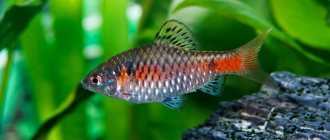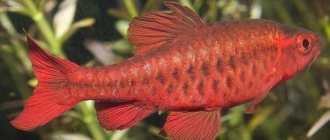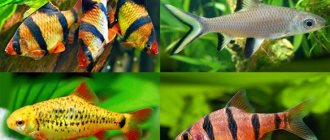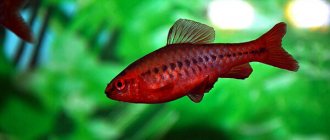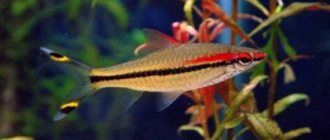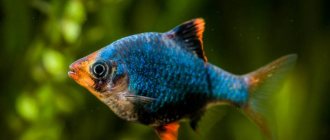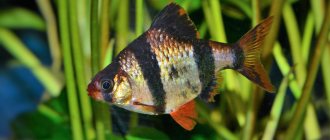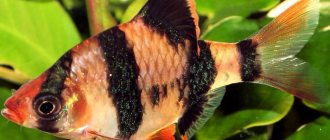04/20/2019Pisces0
A beautiful aquarium pet, the Schubert Barbus, was bred through selective breeding. It is a direct relative of the wild Green Barb, which rarely appears for sale. Thanks to the demand for the species, a hybrid has appeared, which is distinguished by its bright color and is always available.
- 1 Description and natural habitat
- 2 Basics of aquarium keeping
- 3 Compatibility with other types
- 4 Feeding
- 5 Breeding
- 6 Diseases and prevention
Habitat in nature
The barb comes from China and is also found in Taiwan, Vietnam, and is also called the Chinese barb around the world.
The golden form is very popular, but has been withdrawn. artificially, by Thomas Schubert in 1960, after whom it was named. The natural color is more greenish, without a wonderful golden color.
At the moment, it is practically not found in the aquarium hobby, having been completely replaced by artificially bred ones.
In nature, it lives in rivers and lakes, at temperatures of about 18 - 24 °C. It feeds in the upper layers of water, rarely swimming to depths of more than 5 meters.
Introduction
Information about the species' habitats in Laos is scarce, but it is known that the fish is definitely found in the Nam Ou River basin, Phong Saly Province. In Taiwan, the species is endangered due to shrinking habitat and the emergence of other exotic species, while in Singapore and Hawaii the population of Schubert's barbs continues to exist.
As a rule, the fish prefers ponds with standing water or tributaries with a slow flow, swamps, irrigation canals and other similar places. Schubert's barb can often be found in coastal waters with abundant vegetation; schools of fish usually swim at depth, near the bottom.
On Nainan Island, in an area typical for fish, in March 2006 the water reached 1 meter in depth, its temperature was 31.9°C, pH 8.0, electrical conductivity - 102 µS/cm, total water hardness - 2 and carbonate hardness - 2.
Sympatric species are: Chinese rasbora (Rasbora steineri), common macropod (Macropodus opercularis), representatives of the genus Doryichthys sp., as well as the genus Metzia spp. and several species of shrimp from the genus Macrobrachium and Neocaridinia ).
Description
The natural color of the Schubert barb is greenish, but now it is practically not found in aquariums. Almost all fish are artificially bred, and very few quantities are imported from nature.
Upon reaching maturity, the fish develops small whiskers at the corners of its mouth. The color of the fish is golden-yellow, with black stripes and dots randomly scattered throughout the body.
The fins are red, the caudal fin is forked.
They grow up to 7 cm in size, and their lifespan can be about 5 years.
Diseases and prevention
Diseases of aquarium fish occur due to improper care. Schubert barbs are no exception; moreover, due to their hybrid nature, they have reduced immunity. Let's consider possible diseases and treatment:
| Disease | Symptoms | Treatment |
| Gill rot is contagious. | Decreased appetite, friction of the gills against stones and plants, blue spots in the affected area. | The drug Rivanol is used in a general aquarium. |
| Obesity is not contagious. | Body enlargement, apathy. | They are put on a diet for 2-3 weeks. Restore the disrupted diet. |
| Fin rot. Can affect the entire aquarium. | The fins change color and begin to deteriorate over time, the eyes become cloudy. | The disease occurs when the aquarium is heavily polluted and the water is too cold. For treatment, the necessary parameters are restored. |
Infections are treated in a common aquarium, since the virus has already been transmitted to others. When treating non-contagious diseases, it is better to quarantine the fish so that neighbors do not touch it.
Compatibility
Like all barbs, they are exclusively schooling fish. You need to keep them at least 6 pieces, since with a smaller number they become stressed, lose activity and spend more time at the bottom of the aquarium. In addition, such a flock looks very good.
You can keep such a school with most active and small fish. There are reviews from owners that their barbs behaved aggressively, cutting off the fins of their neighbors.
Apparently this is due to the fact that the fish were kept in small numbers and they could not form a school. It is in a school that they create their own hierarchy, forcing them to pay less attention to other fish.
But, since the Schubert barb is an active and fast fish, it is better not to keep it with slow and veiled fish. For example, with cockerels, laliuses or marble gouramis.
Good neighbors will be: zebrafish, Sumatran barb, denison barb and other fish similar to them.
Large invertebrates, such as shrimp, live quietly with them, but they can eat small ones.
Feeding
The diet of Golden Barbs is varied. They eat live and plant food; if they are unavailable, they can be given dry food.
Among the living fish, they like daphnia, bloodworms and tubifex. Semolina, thoroughly washed and steamed, is optimal as a plant food. But the most favorite treat for pets is white bread. Before feeding, it should be thoroughly rinsed in running water to avoid clouding the aquarium. You can also pamper your fish with cottage cheese, grated through a sieve. With such a diet, regular cleaning and replacement of water will be required.
The predominance of plant components in the menu makes the color brighter.
The pet's resistance to stress and its good appetite are an advantage. Even when moving to another aquarium, the fish do not lose activity and eat well.
Keeping in an aquarium
The Schubert Barbus should always be kept in a flock of at least 6 individuals. This way they are much more active, interesting in behavior and less susceptible to stress.
Since this is a rather small fish (about 7 cm), but lives in a school, the volume of the aquarium for keeping is from 70 liters, and preferably larger.
Since they are very active, they need a lot of free space to live. Like all barbs, they love currents and fresh water rich in oxygen.
A good filter, regular changes and moderate flow are highly desirable. They are undemanding when it comes to water parameters and can live in very different conditions.
However, the ideal would be: temperature (18-24 °C), pH: 6.0 - 8.0, dH: 5 - 19.
Breeding
Schubert barbs reach sexual maturity at 8-9 months. The breeding process is simple; you need to prepare a place for spawning in advance.
A container with a size of at least 25 liters and a shallow one is filled with water with the following indicators:
| Temperature, °C | Hardness, dH | Acidity, pH |
| +26…+27 | 8 | 7,2 |
A too harsh environment can be softened with melted water or distilled water.
Place a special mesh or algae on the bottom, pressing them down so that adults cannot climb under them. Be sure to install dim lighting and an aeration system.
A couple or several are planted in the finished spawning tank, it depends on the size of the container, and water is poured from a common aquarium. In the morning, to start spawning, replace 30% of the water with fresh water.
If the couple is not young, you need to separate the fish for 7-10 days. During this period, it is recommended to pamper your pets with live food. After the expiration of the period, repeat the standard procedure.
Immediately after completion of spawning, adults are returned to the aquarium. For eggs, the water temperature and other chemical indicators are kept constant. Lighting and aeration are not turned off. After a few days, the babies will swim and begin to feed them. It is recommended to start with boiled yolk and ciliates.
In a teenage aquarium, it is better to remove the plants and add a couple of snails to dispose of dead eggs. As soon as the fry grow to 6-8 mm in length, they begin to be fed with small daphnia and chopped coretra. By 7-8 months, young animals are transplanted to adults.
Classification
Order: Cypriniformes Family: Cyprinidae Species: Barbus semifasciolatus
The species has a number of synonymous names: Green puntius; Barbodes semifasciolatus; Puntius semifasciolatus; Barbus fasciolatus, Barbus aureus; Barbus sachsii; Barbus hainani; Puntius hainanensis; Barbus fernandez-ypezi; Puntius paucimaculatus.
The origin of the species name “Barbus” from the Latin “barbodes” goes back to the Latin word “barbel” (mustachioed) and the ancient Greek root -oides - “shape, similarity”. The Latin word "semifasciolatus" consists of two parts "semi", meaning "half" and "fasciolatus", which translates as "with small stripes".
Original specimens of the species Puntius semifasciolatus
Individuals reach a length of 65-75 cm.
Puntius semifasciolatus
Recommendations for the content of Schuberts
The Schubert barb is a schooling fish, so it is better to stock 8-10 representatives of the species at once. Spends most of its time at the bottom of the water layer of the aquarium. Although these are very peaceful fish by nature, if there is not enough live food, they can tear off the fins of other fish, especially if they are veiled or strongly protruding.
In order for barbs to feel comfortable, they need a rectangular aquarium with a volume of more than 50 liters. It is better to cover the top of the aquarium with a special lid or glass.
Dark soil is placed at the bottom and live plants are placed. As a primer, you can use granite chips, the fractional size of which will be 4-6 mm.
Lighting plays an equally important role. For this purpose, in practice it is better to use fluorescent lamps. As for the intensity of lighting, the main thing here is to know when to stop, otherwise the fish may lose their colorful color.
You can ensure a comfortable stay for fish in the aquarium with the help of regular aeration and filtration, and you should not forget about changing part of the water weekly.
Schubert barbs are unpretentious and omnivorous in nutrition. They can be given plant, live or dry food. Finely grated cottage cheese, chopped lettuce or cabbage leaves, pre-treated with boiling water, will help diversify the diet.
Reproduction
Reproduction of the Schubert barb is also possible in a general aquarium, but it is better to use a separate spawning container to protect the eggs. To get more offspring, select the largest female from the pack and two bright males. It is advisable to keep them separately for a week and feed them plenty of natural food.
As a spawning tank, select a container of up to 30 liters. It must be filled with settled water, the temperature of which should not fall below +25–27 °C. You can plant the spawning ground with small-leaved plants, the tops of which should not reach the surface of the water by 10 centimeters.
Important! After spawning, adult barbs must be quickly removed from the spawning tank, otherwise they may eat the eggs.
It is advisable to place a shelter for the female at the bottom - during the spawning period the male can become aggressive. It is also necessary to equip the container with a separator mesh. A filter in the spawning tank is not necessary, but it is still better to install it, just turn it on at minimum power.
Selected and fattened future parents are placed in the spawning tank in the evening, and in the morning they can begin to spawn. The female usually lays 200–300 eggs at a time.
After this, add fresh water at the same temperature (up to 20% of the total volume).
A day or two after spawning, the fry will appear. At first they will feed on the reserves of their yolk sac, but as soon as the babies begin to swim, they must be fed with “live dust”, special food for fry or ciliates.
The following are often used as food for fry: daphnia, gammarus, rotifers and cyclops.
Both eggs and fry are very sensitive to sunlight, so the spawning tank should not be in direct sunlight.
After a couple of weeks, grown fish can be moved to a large aquarium, and they will reach sexual maturity in 8–11 months.
What to feed the fish
For good health, fish need a varied diet. High-quality dry food in the form of chips, flakes and even catfish tablets and sticky tablets are suitable. Be sure to include live or frozen food in your diet, such as bloodworms and brine shrimp.
To prevent pets from nibbling on plants, give them cucumber, spinach, zucchini, pumpkin or lettuce several times a week. Pre-cook the vegetables for 1-2 minutes in boiling water.
Feed your barbs a little every day. Under no circumstances should you add too much food, as barbs are prone to obesity.
Reviews
Schubert's barb is valued for its appearance and peaceful disposition. The fish is curious and monitors its surroundings outside the aquarium. A tendency to damage plants is noted.
Fish from the same family:
- Goldfish "Water Eyes" (Carassius auratus)
- Veiltail goldfish (Carassius auratus)
- Danio rerio (Brachydanio rerio)
- Danio equipinnatus. Malabar danio (Danio aequipinnatus)
- Cardinal (Tanichtys albonubes)
- Green Labeo (Labeo frenatus)
- Labeo bicolor
- Danio blue. Thai Danio (Brachydanio kerri)
- Danio pearl. Pink Danio (Brachydanio albolineatus)
- Leopard danio (Brachydanio rerio var. frankei)
- Spot zebrafish (Brachydanio nigrofasciatus)
- Common verkhovka (Leucaspius delineatus)
- Common gudgeon (Gobio gobio)
- Minnow. Demoiselle minnow (Phoxinus phoxinus)
- Danio devario
- Laubuka Dadiburjora. Chela dadiburjori
- Indian laubuca (Chela laubuca)
- Gorchak (Rhodeus sericeus amarus)
Notes
Schubert barb is known by other names - “green” or “Chinese” barb.
Natural “green” coloring is not in demand in the aquarium hobby. On the other hand, the artificially bred "golden" variation is grown in large numbers and is one of the most popular freshwater fish species. The “golden” color first appeared in the 1960s, and is now common almost everywhere, so many lovers consider it natural.
Unfortunately, the fish that are bred for sale have been selectively selected for many decades, so each generation is slightly different. Thus, compared to wild representatives, domestic barbs have noticeably smaller fins, and other deformations also appear. From time to time, albinos can be obtained through selection.
In the literature on fish breeding, it is the golden variation that appears under the name Schubert Barbus. However, this name is not official. It was invented by the American Thomas Schubert, who was the first to develop a fish with a new color.
This species was previously included in the genus Puntius, which was believed for many years to include more than 100 species of small to medium-sized fishes in the Cyprinidae family, until in 2012 Pethiyagoda et al. (2012) did not publish a review covering selected South Asian fish species.
Most of the Puntius species have been reclassified into new genera: Dawkinsia, Dravidia (later assigned to the genus Haludaria), and Pethia. The remaining species are classified as the genus Barbus or the genus Sistomus. The latter genus has changed several times, taking into account the fact that some species of south-east Asia, previously included in it, were excluded.
In 2013, Kottelat (2013) published a comprehensive edition updating the list of fishes of southeast Asia, moving the barb from the genus Puntius to the genus Barbodes, indicating that the green puntius "may have a separate origin." Members of the named genus, unlike other genera, had the following aspects of ontogenetic development: in young individuals, from 3 to 5 points are visible along the median lateral line, including one located in the middle of the caudal fin, and another on the dorsal fin. These spots increase in size, often new ones appear, which then form a whole stripe or even a wide stripe, and a point on the dorsal fin can become either a large spot or a wide stripe.
In addition, to identify the genus Barbodes spp. The following descriptions may be useful: the last ray of the dorsal fin has serrations along the posterior edge; the fish have clearly visible whiskers (with the exception of the species Barbodes aurotaeniatus), and there are whiskers on the jaws; the lips are smooth and thin, the postglabial groove is interrupted in the middle, the lateral stripe can be either complete or incomplete, usually consisting of 22-32 scales; ½4/1/4½ scales between dorsal fin and ventral midline in front of pelvic fins, 12 rows of rounded scales; 12 to 15 gill rakers on the first gill arch. —— www.seriouslyfish.com www.thespruce.com/ fishbase.org
Schubert's barbs - sexual dimorphism
It is almost impossible to distinguish the sex of juveniles, and even in adult Schubert barbs , sexual dimorphism is not so obvious; males are slightly smaller than females and more brightly colored. Sexually mature females are distinguished by a clearly visible rounded abdomen. In addition, the black spots mentioned above may be completely absent in females or may be less contrasting than in males.
Having gained experience in keeping and breeding these fish, you can easily form pairs for spawning, accurately distinguishing males from females.
Lifehacks and tips for aquarists
- Tip #1. Experienced aquarists recommend placing two males per female in the aquarium during spawning.
- Tip #2. The diet of Puntius Semifasciolatus var. Schuberti 2-3 times a month it is recommended to include enchitra in small portions.
- Tip #3. Some aquarists organize uneven lighting to keep together light-loving plants and barbs that prefer shaded areas. To do this, the center is left dimly lit, and the strongest illumination is done along the edges of the aquarium.
Previous
Fish Cichlazoma Meeka - an intelligent and curious aquarium inhabitant
Next
FishTernezia: a beautiful South American fish that will suit everyone
